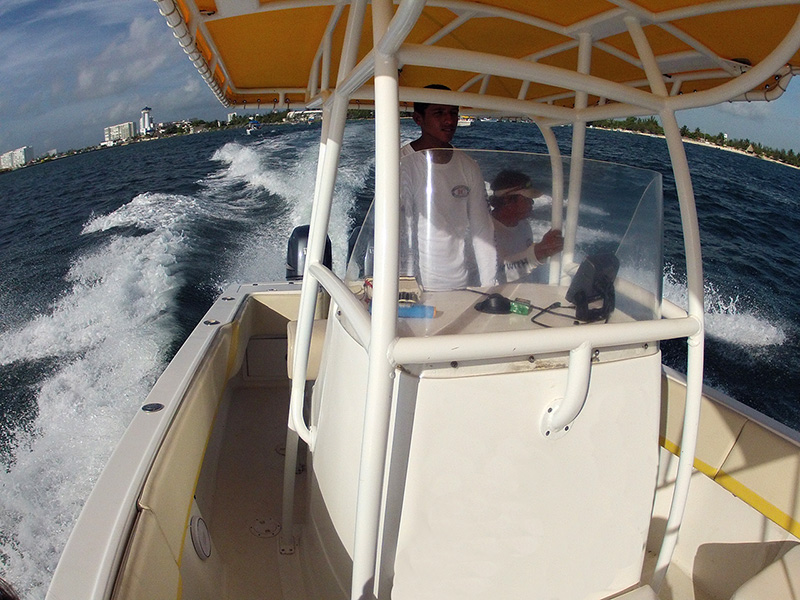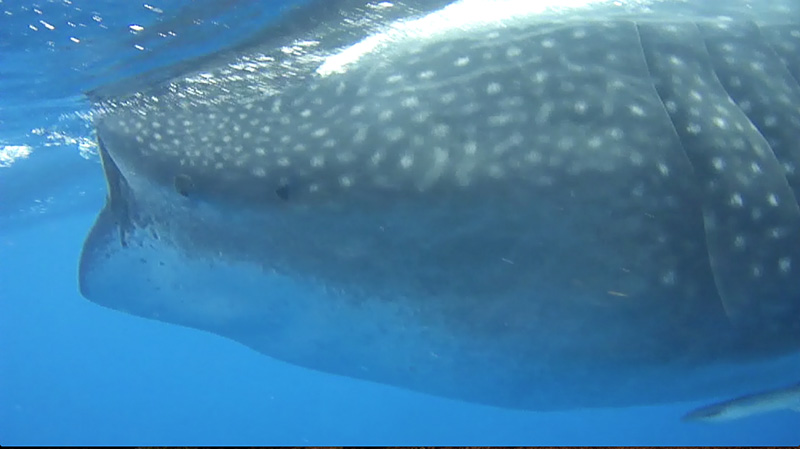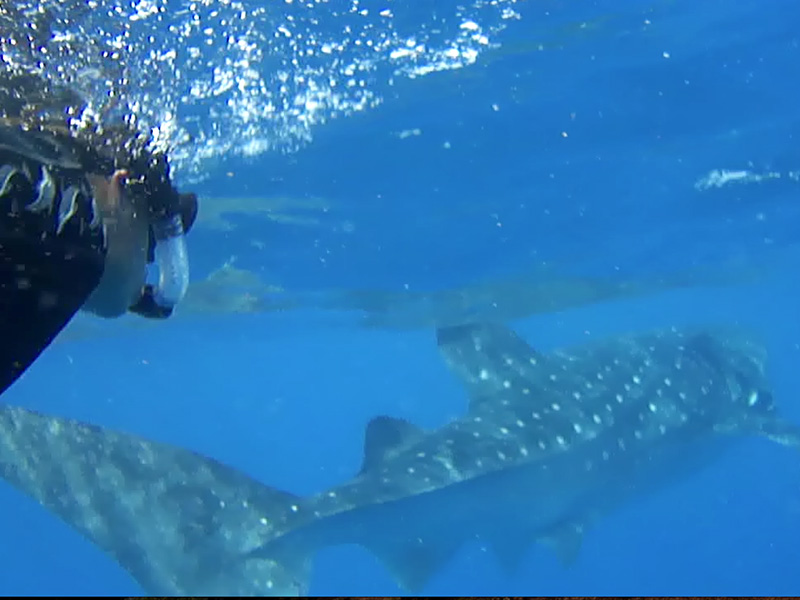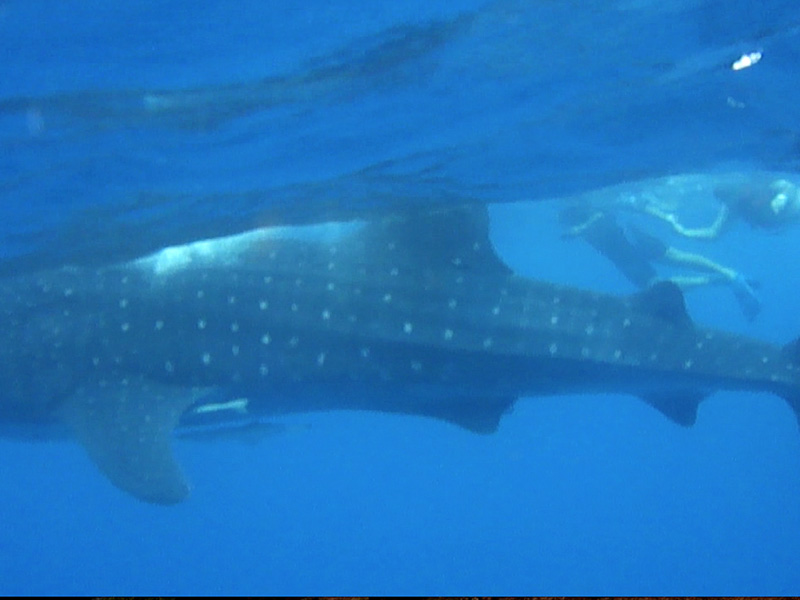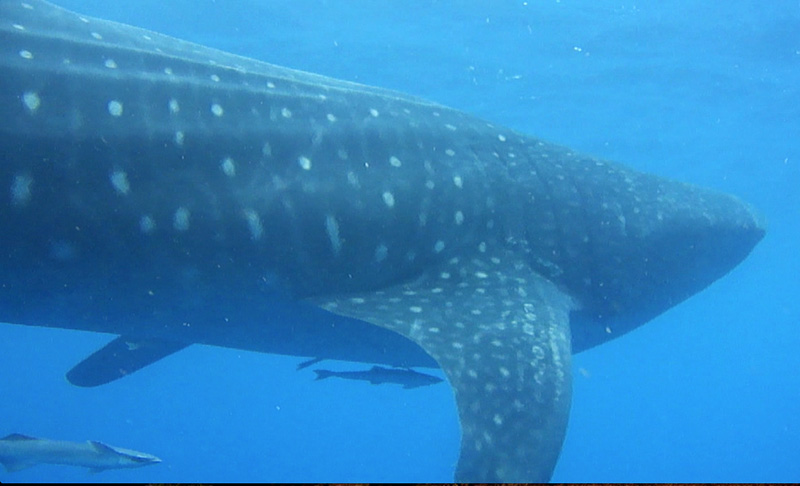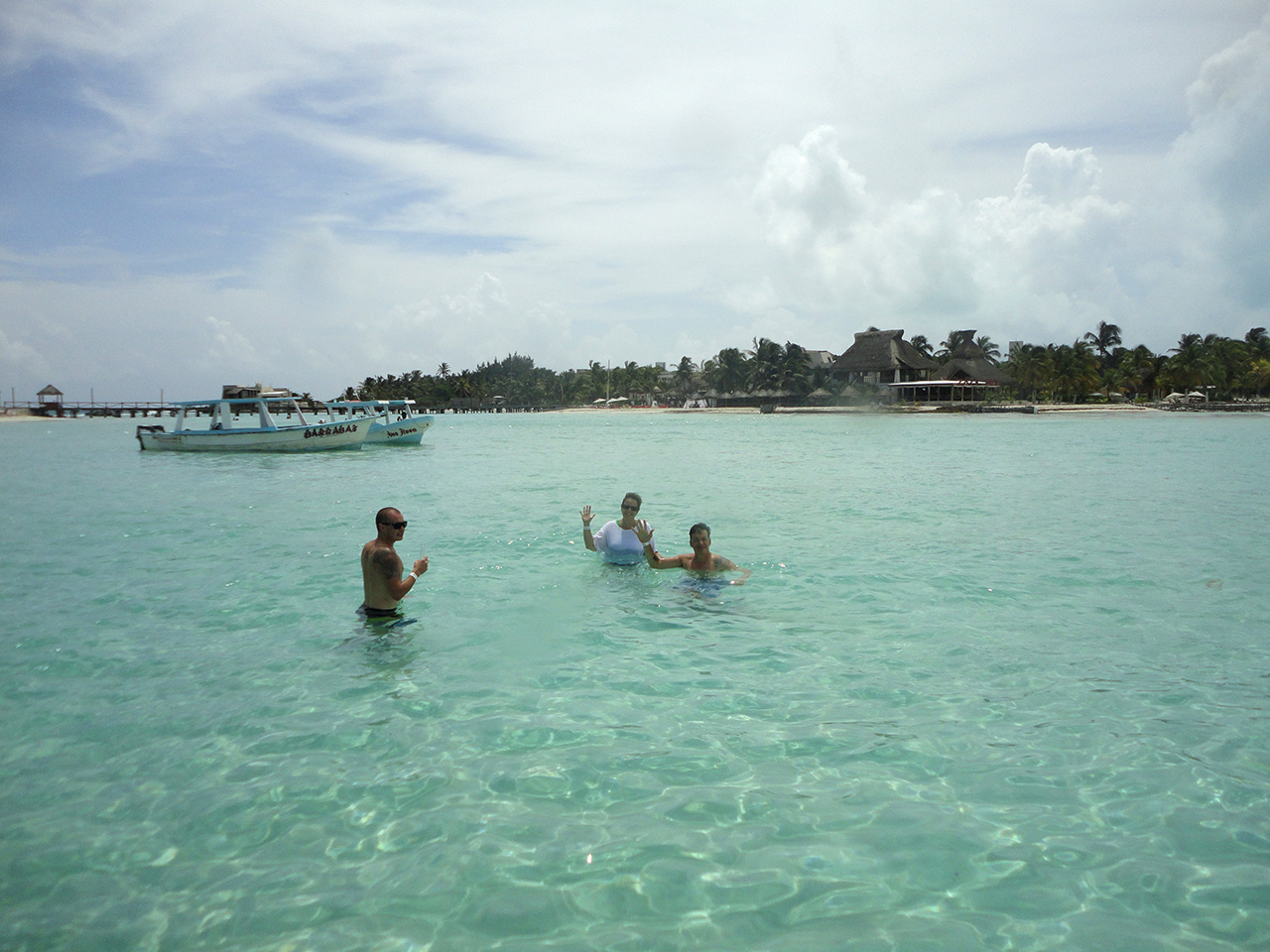A Different Kind of Shark Encounter…
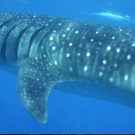
We arrived in Mexico late in the afternoon on 8/29/12 for the specific purpose of swimming with and participating in conservation efforts of Whale Sharks – a once in a lifetime experience. The Caribbean sea off the coast of Cancun is the only known place on Earth where these magnificent creatures migrate to feed from mid-May to mid-September at the surface of the water where swimmers can view them. In the area of “blue water” that is located Northeast of Isla Mujeres there are huge groups of up to 400 whale sharks that converge to feed.
Whale Sharks (Rhincodon typus) are the largest fish in the world and are gentle filter-feeders that pose no harm to humans. They can grow up to 45 feet long and can weigh over 15 tons. In some parts of the world, the whale shark is hunted for human consumption and its liver oil is used commercially.
Early Thursday we met with our local contact in Mexico to finalize plans for the experience. Since we learned the Port of Juarez in Cancun (where the Operators depart from) was closed all week due to heavy winds and surf, we decided to plan the excursion for Friday, 8/31. Unfortunately, the Port remained closed on Friday and our only option was Saturday – since our flight back to the US was scheduled for the following day. We were told it may not happen as others had to leave without being able to gain access to the sharks before their departures. So we kept our fingers crossed that the Port would be open on Saturday since this was the whole reason for the trip. As adventurers we knew that while the best planning can increase the odds of a great experience, there are extenuating circumstances that can arise that make an experience a no-go! This is one of the risks explorers and adventurers face.
Saturday morning arrived and there were no messages from our local contact telling us the trip was off so we met our transport at 6:30am for the hour drive to Puerto Juarez to meet our Operators -Caribbean Connections (CC’s).
Marta and Aldo, a husband-wife team from CC’s have been leading these encounters for 9 years. A portion of the proceeds from their excursions and sales of photos funds conservation efforts of the sharks. After each feeding season CC’s will purchase tracking devices at $4,000 USD each so biologists can affix them to the dorsal fins of the sharks and learn more about them. Their biologists work with Atlanta’s Georgia Aquarium in the US who have four whale sharks in captivity – more on this later.
Marta explained that laws regarding conservation of the sharks in Mexico have become much more strict in recent years. Mexico declared the whale shark a protected species in 1994 and declared the area of Yum Balam (feeding area) a protected area. In 2009 the Mexican government announced another 145,980 hectares of protected area up to the Island of Contoy a/k/a “blue waters”. Operators are required to have licenses to take people to the shark feeding locations. There are only four operators with licenses – one being Caribbean Connections. She said within a few years the law will change where people will only be allowed to view the sharks from the boats and will not be able to enter the water with them. We knew this was something special and unique and felt very fortunate to be participating in conservation efforts of a great species.
Our day started with Marta checking us in and then ensuring we knew the rules for the day:
1 – never touch the sharks- it’s illegal to do so,
2 – only 2 people plus the guide in the water from each boat at a time,
3 – use only Eco biodegradable sunscreen for the safety of the sharks, and
4- enjoy, encounter and experience!
Since the entire week of excursions had been postponed, unfortunately there were many others who were pushed to this day for their experience. In all there were about 15-20 boats each holding about 7-10 swimmers. However, we had decided earlier that we would charter our own boat to ensure an optimal experience so there was only the 3 of us with our Captain and our Guide on our boat. This assured more time in the water with the sharks and more flexibility in determining search options.
We were assigned to Boat #5 – our Captain was Luis (21 yrs old) and our Guide was Willy (26 yrs old). These young men were locals who spent their entire lives on the water and were accomplished Seamen, even at their young ages! We were assured we were in good hands by Marta.
The boats left the Port and headed for the shark feeding grounds about 28 miles offshore from Isla Mujeres where there were upwards of 50+ whale sharks feeding. Why Isla Mujeres? We were told this is a favorite spawning ground for Tuna who deposit their eggs here – a favorite food of the Whale Sharks. The eggs are clear and miniscule so they don’t affect visibility in the water. Whereas, in Hol Box (another local feeding spot a few hours north) the Whale Sharks feed on plankton which clouds visibility in the water making the experience a little more difficult.
The Captains all work together to locate the sharks since they move around as they feed. We were told it can take 45 – 90 minutes to find them, if at all. The winds were blowing at 13 knots and the swells were about 10 feet making the search somewhat rough. About 25 minutes into the search Willy informed us that the sharks were spotted by local fishermen and our boat was headed to those coordinates. Great news indeed!
As we arrived at the feeding grounds we could see the outlines of these great majestic creatures as they filtered the food into their gaping mouths. It was such an amazing site to see! With their tail and dorsal fins rising above the surface of the water one could sense their immense size. Yet they could glide fluidly through the water as if weightless in space while they fed. Their appearance was like something out of Jurassic Park, evolved over eons to become the filter machines we were watching.
Our guide instructed us to don our snorkel gear and wetsuits to ready ourselves to enter the water as our captain carefully positioned the boat near several sharks that were feeding. Our guide gave the green light and Brandon was the first to enter the water which was upwards of 150 feet deep with visibility at about 40-50 feet. Brandon and Willy swam close to observe the sharks underwater. They didn’t seem bothered at all by the awkward humans who seemed intent upon gazing at them while they ate. As one shark swam away another turned and headed straight toward Brandon with it’s mouth gaping as it filtered Tuna eggs. Brandon quickly moved away to allow the shark to feed effortlessly.
As Brandon boarded the boat to rest, Art and I jumped in the water with Willy. I immediately lowered my mask and snorkel below the surface and saw the most amazing sight I had ever seen – the shark seemed about 30 feet long and was descending to deeper depths.
The water shimmered off of the white spots along its body which are arranged uniquely on each shark, as finger prints are to humans. I watched as it slowly faded into the azure blue water and eventually out of sight. Art and Willy swam toward several others that were skimming the surface for food.
As we swam with the sharks we noticed many had hitch-hikers. Much smaller in size, Remoras seemed to be clinging to the body of the whale sharks. These fish use suction discs to attach themselves to their larger hosts to gain a free ride and a possible free meal. While not quite symbiotic, this relationship seems very beneficial to the Remora.
We were surprised that none of the whale sharks we encountered were tagged with tracking devices or tags as we were anxious to photo any info from the tags to report back to biologists at www.whalesharkproject.org for conservation data. This project works in collaboration with other whale shark projects around the globe and aims to encourage anyone who encounters whale sharks to be involved in active conservation efforts. Biologists like those from the Georgia Aquarium previously mentioned can benefit from this data. Since the patterning of the spots and coloration is unique to each individual, Art will be uploading the photos and videos we captured of the sharks to their website as that data will assist with building their database of information to gain further insight into the migration habits, biology and populations of these amazing animals. This type of data is crucial to biologists since access to wild populations is expensive and time-consuming.
After spending about 3-4 exhilarating hours with the whale sharks we were exhausted and ready to head back to shore. Our captain brought us to a beautiful shallow cove off Isla Mujeres where the water was crystal clear and Caribbean blue. We anchored just off the beach to enjoy cervesa and ceviche while discussing the amazing experience we just had!
When we posted our upcoming adventure on Facebook, there were many comments related to this being on people’s “bucket list”. When we decide to have an experience such as this, whether locally or elsewhere, we always try to build in a component where we will learn more about the natural world and try to make a difference. With science budgets being affected by limited donations and funding, as stewards of the planet it is our job to give back when possible. Consider contributing to conservation efforts in any way possible by collecting, photographing and/or reporting data to organizations that can benefit the world as a whole.




